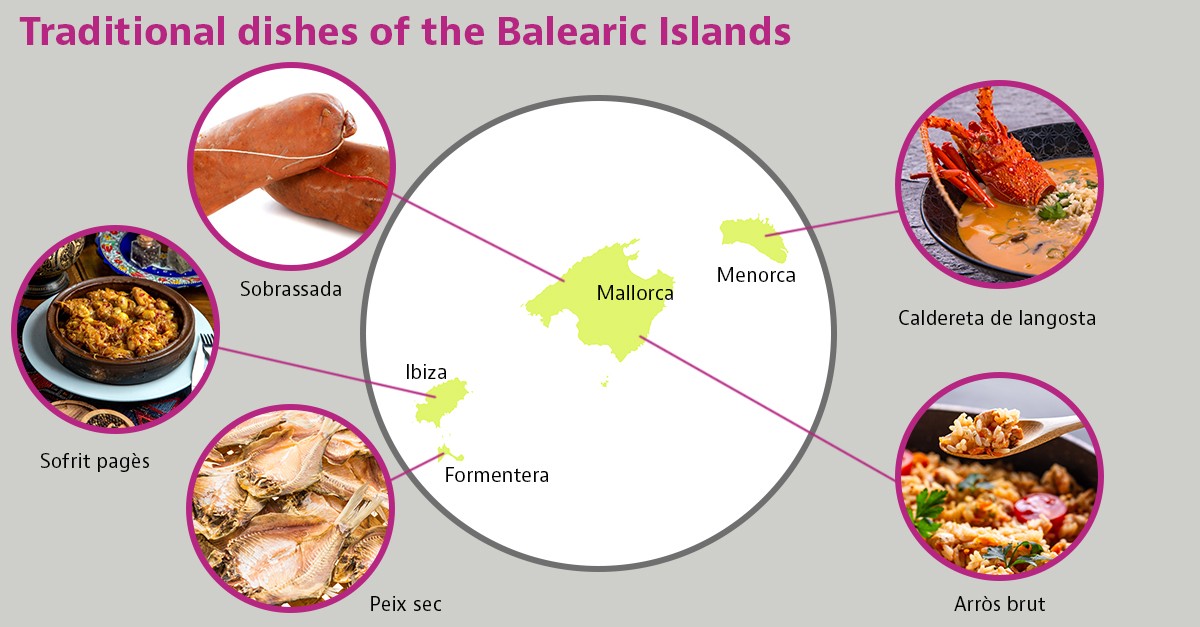
Visitors to the Balearic Islands don't only love their idyllic landscapes and crystal-clear beaches but also their rich, time-honoured cuisine that reflects centuries of history, cultural fusion and a deep respect for local ingredients.
Rooted in ancient traditions and shaped by Arab and Catalan influences, Balearic gastronomy varies from island to island. Here’s a taste of some of the region’s most iconic products and dishes.
Sobrasada
Sobrasada is undoubtedly one of the most iconic and recognisable cured meats of the Balearic Islands. Produced mainly in Mallorca and Menorca, it’s known for its soft, spreadable texture and deep reddish hue, thanks to the generous use of paprika.
Made from lean pork, bacon, salt, pepper and a blend of spices, the mixture is stuffed into natural casings and slowly cured in the islands’ mild, humid Mediterranean climate. The result is a rich, aromatic sausage with a distinctive flavour profile.
Traditionally spread on rustic bread or used in local recipes, sobrasada is incredibly versatile – equally delicious in savoury stews or paired with honey for a sweet contrast.

Arròs brut
Arròs brut is a beloved traditional dish from Mallorca, whose name – meaning "dirty rice" – refers to the dark, cloudy appearance of its rich broth, tinted by a blend of spices and meats.
Hearty and deeply aromatic, it’s the perfect comfort food for cooler days or festive family meals. The dish typically features rice simmered with a variety of meats such as pork, chicken and occasionally rabbit, along with local cured sausages like sobrasada or butifarrón, seasonal vegetables and a generous mix of spices.
Slow-cooked in a flavourful broth, arròs brut is a staple of Mallorcan cuisine, cherished by locals and visitors alike for its depth, warmth and unmistakably rustic character.
Sofrit pagès
Sofrit pagès is a traditional dish from Ibiza that captures the rustic spirit and celebratory roots of the island’s cuisine. Deeply tied to local farming traditions, it’s a flavourful stew that pays homage to both the land and the custom of making the most of every ingredient.
Meaning "peasant stew", this dish was once reserved for festive occasions and family gatherings. Its richness lies in a generous mix of meats – typically lamb, chicken, pork and cured sausages like sobrasada and butifarrón – combined with potatoes, garlic, peppers and a carefully chosen blend of spices.
Added to this are potatoes, garlic, peppers, and carefully selected spices. All of this is slowly cooked until it achieves a mellow texture and a deep flavour that captivates anyone who tries it. It's often found on tables during traditional festivals.
Caldereta de langosta (lobster stew)
Lobster stew (caldereta de llagosta) is undoubtedly the star dish of Menorca. A symbol of the island’s culinary identity, this traditional recipe features fresh lobster caught in the surrounding waters and is often enjoyed on special occasions or summer gatherings by the sea.
The lobster is gently simmered in a rich sofrito of onion, garlic, tomato and pepper, then enhanced with a flavourful fish stock and aromatic herbs. The result is a deeply savoury, aromatic dish with a delicate texture and unforgettable taste.
Traditionally served with slices of rustic bread (pan payés) to soak up the broth, this stew is a must-try for anyone seeking the true flavour of Menorca.

Peix sec
Peix Sec holds a special place in the culinary heritage of Formentera and the Balearic Islands. This traditional dish, whose name means "dried fish," originated as a method to preserve seafood using the Mediterranean sun and breeze.
Typically made from white fish like ray or cod, the fish is cleaned, cut into pieces and sun-dried to develop its distinct texture and rich flavour.
Once dried, the fish is shredded and added to local dishes – most notably the “salada payesa,” a classic salad combining peix sec with potatoes, peppers, onions and olives, celebrating the island’s authentic flavours.
Foodie experiences on the Balearic Islands
If you’re wondering where to dine on the Balearic Islands, each island presents its own culinary journey, where tradition, innovation and local produce come together in markets, family-run eateries and centuries-old wineries.
From the inland villages of Mallorca, where the scent of sobrasada and freshly baked bread fills the air, to the fishing harbours of Menorca and Formentera, where fresh seafood takes centre stage, Balearic cuisine offers a wealth of options.
Foodie experiences invite visitors to savour typical Balearic desserts like the Mallorcan ensaïmada. Meanwhile, in Ibiza, rural experiences lead to agrotourism farms where sofrit pagès and flaó are crafted using recipes handed down through generations.
- Property for sale on the Balearic Islands
- Long-term rentals on the Balearic Islands
- Holiday rentals on the Balearic Islands
